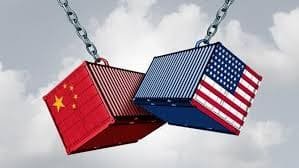China 84% Tariffs on US Goods have marked a major escalation in the ongoing trade tensions between the United States and China. These steep retaliatory tariffs have been imposed on a wide range of US exports and are seen as a direct response to recent US protectionist policies, especially the tariff threats made by former President Donald Trump.
Significant implications have been triggered across international trade routes, supply chains, and investment outlooks due to this tariff increase. With global economic uncertainty already heightened, the latest tariff retaliation by China has added another layer of complexity to international trade relations.
Background: China 84% Tariffs on US Goods Rekindle Trade War
The trade war that began during the Trump administration had already laid the foundation for tariffs and trade restrictions on both sides. Although a temporary phase-one deal was signed in January 2020, tensions had never truly dissolved. With fresh US tariff threats reignited in 2025, especially involving technology and automotive imports, the Chinese government has been prompted to strike back.
It has been indicated by Chinese officials that their decision had not been made lightly. However, it was emphasized that sovereignty, economic security, and fairness had to be safeguarded through appropriate means.
Products Affected by the 84% Tariffs
A variety of US-exported products have been targeted under the new tariff rules. Industries such as agriculture, automotive, chemicals, and electronics have been severely impacted. According to official announcements, the following product categories have been particularly affected:
- Agricultural Goods: Soybeans, corn, wheat, and pork have been hit with the highest tariff brackets, raising costs dramatically for Chinese importers and consumers.
- Automobiles: American-made cars and automotive parts are now subject to tariffs of up to 84%, potentially pricing them out of the Chinese market.
- Technology and Semiconductors: Advanced tech equipment, data storage units, and chips from the US have also been affected.
- Energy Exports: US oil and LNG (liquefied natural gas) exports to China will face added duties, likely leading to a shift in sourcing strategies for Chinese buyers.
These tariffs have been strategically designed to hit both symbolic and economically significant sectors of the US economy, ensuring maximum leverage during any future trade negotiations.
Global Markets React
Sharp reactions have been seen in global stock markets following China’s announcement. The S&P 500 and Dow Jones Industrial Average experienced notable drops, while Asian markets responded with heightened volatility. Investors have been spooked by fears of an extended trade war that could result in slowed global growth.
Currency fluctuations have also been reported, with the Chinese Yuan witnessing slight depreciation and the US Dollar Index dropping against a basket of major currencies. Safe-haven assets such as gold and Treasury bonds have seen increased demand amid growing uncertainty.
Impact on US Businesses and Farmers
US businesses, especially those with significant export volumes to China, are expected to bear the brunt of these new tariffs. American farmers, who had previously suffered during the initial stages of the trade war, may face reduced demand once again.
Farmers had relied heavily on China for agricultural exports, and the reintroduction of harsh tariffs may force some to reduce output or seek alternative markets. Additional federal assistance may be required to cushion the blow, although political willingness for further aid remains unclear.
Moreover, manufacturers in the automotive and electronics sectors have voiced concern over plummeting competitiveness in one of the world’s largest consumer markets. If sustained, the impact of these tariffs could reduce overall export revenue and employment in related industries.
Impact on Chinese Consumers and Supply Chains
Although intended as a strategic countermeasure, the new tariffs could also create economic consequences within China. Higher prices for imported American goods may be faced by Chinese consumers. However, these effects may be softened by diversification efforts and the exploration of alternative suppliers in countries such as Brazil, Vietnam, and Australia.
Chinese companies have also been accelerating the development of domestic alternatives to US technologies and agricultural imports. Through subsidies and innovation incentives, long-term resilience is being sought in critical sectors.
The tariffs are expected to further decouple certain parts of the US-China trade relationship, particularly in sectors considered sensitive to national security and technological self-reliance.
International Reactions
Global leaders and international organizations have expressed concern regarding the escalating tensions. The World Trade Organization (WTO) has urged both nations to seek diplomatic resolutions and avoid measures that could trigger a global trade slowdown.
The European Union and several ASEAN countries have called for restraint and dialogue. While some countries may benefit from a rerouting of trade flows, the instability created by these tit-for-tat tariffs has been regarded as detrimental to global economic health.
The Political Angle
The political ramifications of China’s tariff announcement have been felt in Washington, where lawmakers remain divided. Some have supported a tough stance against what they view as unfair Chinese trade practices, while others have warned that escalating the situation could be economically disastrous for US businesses and consumers.
The timing of the tariff retaliation—so close to the US presidential election cycle—has been considered significant. With trade policy likely to be a major issue during campaign debates, the economic fallout of this development could shape public opinion in crucial swing states.
Possible Future Developments
Several scenarios may emerge from the current standoff:
- Negotiations and Rollbacks: If pressures mount on both sides, a return to the negotiating table could lead to mutual tariff reductions or a new trade deal.
- Escalation: Further retaliatory measures could be imposed, widening the trade war and affecting more industries and countries.
- Trade Realignment: Long-term shifts in global trade partnerships may be accelerated, leading to more regionalization and less reliance on bilateral trade between the US and China.
Global supply chains are being reevaluated, and the broader economic impact of this ongoing conflict will unfold in the coming months.
Conclusion
The imposition of up to 84% tariffs on US goods by China has marked a critical moment in global trade relations. As both superpowers navigate this complex economic and political chessboard, businesses, investors, and policymakers around the world are bracing for further developments.
While short-term disruptions are already being witnessed, the long-term effects will depend on the strategic choices made by both Washington and Beijing. Amid uncertainty, one fact remains clear: the path to economic cooperation has become more treacherous, and the stakes have been raised higher than ever before.


